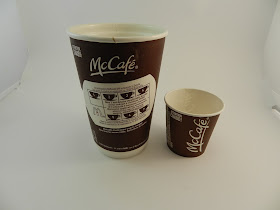I asked her for her cups when she was done. (She is also a math teacher so understands that this is not a creepy request. It is no weirder than the time I bought 400 ping pong balls, or 1500 bendy straws). I then made her a request to buy a large and small coffee in the future and save me the cups.
The result was a family of coffee cups stored in the bottom cabinet behind my desk. I had a student in a grade 10 photography class take pictures of the cups in various arrangements.
The result is a simple task:
Are the coffee cups similar?
I'm hoping that various lines of reasoning emerge. Personally, I love that the diameter of the two largest cups (Large and Medium) is the same. This means that a student could pick up on the fact that a scale factor of one cannot possibly exist between their heights so they cannot be similar.
I assume that some type of prerequisite knowledge would lead some to create the (scaled / original) ratios to determine that they are not similar.
I am hoping that the fact that the two middle cups (sizes Medium and Small) have exactly a 1 cm difference in diameter sparks a conversation. I often have students dealing with scale factor as an additive relationship. (i.e. Diameter is 1 more, and height is 2.3 more, so scale factor is 2.3). If this comes up organically, it is a huge win.
After initial conversations, I am planning on giving groups of students extension tasks:
Design an XL cup that is 1.3 times the Medium cup.
Design a cup that is similar to the size Small.
Design a cup similar to the Medium cup, but no taller than the Large cup.
What would the height of the Large cup need to be to make it similar to the XSmall cup?
How much taller would the Small cup need to be to fit a Large lid?
Students finish at various paces, and with varying degrees of work. I love it when students are not working and have a fantastic reason for doing as such. I asked a group if the Medium and XSmall cups were similar, and one student told me that he didn't need to do the calculation. He reasoned that he could tell the height was increased by a scale factor grater than 2 (12.9 / 6) and the diameter of the Medium cup was not close to double the diameter of the XSmall cup (8.9 / 6.3). Therefore, the cups couldn't possibly be similar.
Genius.
If you wanted to direct the class toward scale factor in 2D & 3D, you could assume the cups are cylindrical (or pieces of cones) and ask:
Which cup offers the best bang for your buck?
How many XSmall cups of coffee will fit into a Large cup?
Design a cup that has exactly twice the coffee as the Medium cup.
I suppose the point here is: tasks don't have to be amazingly unique contexts. Great mathematical opportunity can be found in regular places, teased out with curiosity, heightened with interesting questions, and curated through collective action.
NatBanting
** Jim Doherty wrote a post putting his spin on the same activity. Read it here **



No comments:
Post a Comment